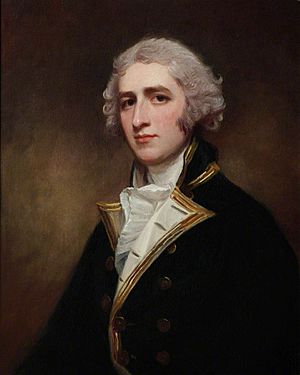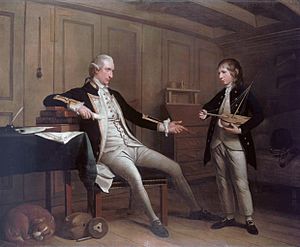William Bentinck (Royal Navy officer) facts for kids
Quick facts for kids
William Bentinck
|
|
|---|---|
 |
|
| Governor of Saint Vincent | |
| In office 1798–1802 |
|
| Monarch | George III |
| Preceded by | James Seton |
| Succeeded by | Henry William Bentinck |
| Personal details | |
| Born | 17 June 1764 |
| Died | 21 February 1813 (aged 48) Saint Petersburg, Russia |
| Military service | |
| Allegiance | |
| Branch/service | Royal Navy |
| Years of service | 1783–1813 |
| Rank | |
| Commands | HMS Assistance HMS Adamant HMS Phaeton HMS Tremendous |
| Battles/wars | |
William Bentinck (born June 17, 1764 – died February 21, 1813) was a brave officer in the Royal Navy. He also served as the governor of Saint Vincent from 1798 to 1802. During his long career, he rose to a very high rank: Vice-Admiral of the Blue. He was also a Fellow of the Royal Society, which means he was recognized for his contributions to science.
Contents
William Bentinck: A Life of Service
His Family Life
William Bentinck's father, John Bentinck, was also a captain in the navy. His mother was Renira van Tuyll van Serooskerken. William's grandmother, Charlotte Sophie of Aldenburg, was a ruler in Aldenburg. She had important connections to the Russian royal family, including being a cousin to the mother of Catherine the Great. These family ties might have helped William later in his career.
In 1802, William married Frances Augusta Pierrepont. They had eight children together, but only four lived to be adults. Their oldest son, George Bentinck, later became a Member of Parliament (MP). This means he was elected to help make laws for the country.
William Bentinck started his naval career at a young age. When he was just nineteen, he was given command of a 50-gun ship called Assistance. This was during the end of the American War of Independence. After the war, some of his crew tried to run away. A small boat was sent after them, but it got stuck, and the crew members died from the cold.
William also sailed on other ships. He commanded Atalanta from Nova Scotia to Prince Edward Island in 1784. He also took Felicity to Cape Breton Island, carrying the governor.
Important Battles and Commands
During the War of the First Coalition (a war against France), William commanded two more ships: Adamant and later the frigate Phaeton. With the Phaeton, he took part in a major naval battle called the Glorious First of June against the French navy. Soon after this battle, he was moved to command a larger, 74-gun ship called Tremendous.
In 1787, William Bentinck was chosen to be a Fellow of the Royal Society. This is a special honor given to people who have made important discoveries or contributions in science.
Life as a Governor
From 1798 to 1802, William Bentinck served as the Governor of St. Vincent and the Grenadines. A governor is like a leader or administrator for a colony or territory. During his time as governor, he traveled quite a bit. He even wrote down sailing instructions for many harbors in North America and the West Indies.
Rising Through the Ranks
After his time as governor, William Bentinck likely returned to England. In 1805, he was put in charge of the Sea Fencibles. This was a special coastal defense group that protected England from a possible invasion by France.
Over the next few years, he was promoted quickly. He became a Rear-Admiral of the Blue in 1805, then a Rear-Admiral of the White in 1808. Finally, in 1810, he reached the high rank of Vice-Admiral of the Blue.
Peacemaking Efforts
In 1812, Europe was in the middle of the Napoleonic Wars. Britain, Sweden, and Russia needed to stop fighting each other to unite against France. William Bentinck played a special role in bringing peace. Because of his family connections to the Russian court and his good relationship with the Swedish Crown Prince, he traveled between Saint Petersburg (in Russia) and Stockholm (in Sweden).
He helped arrange an important meeting in August 1812 in the city of Åbo. At this meeting, Tsar Alexander I of Russia and the Swedish Crown Prince Bernadotte met to discuss peace.
It's not fully known if the British government officially sent him on this mission or if he acted on his own. The American ambassador in Saint Petersburg, John Quincy Adams, wrote about Bentinck's secret peace efforts. Sadly, William Bentinck died shortly after these events, on February 21, 1813, in Saint Petersburg, from typhus.


